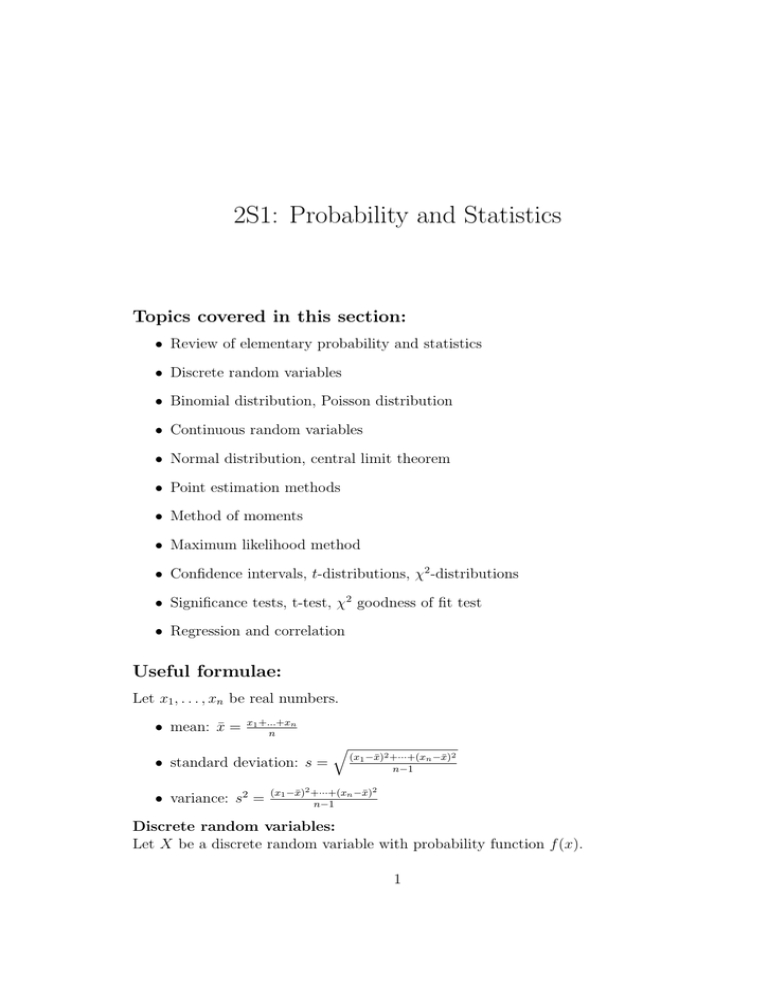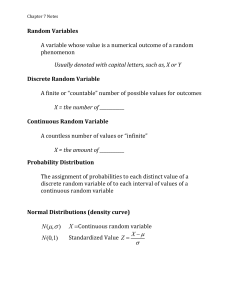2S1: Probability and Statistics Topics covered in this section:
advertisement

2S1: Probability and Statistics Topics covered in this section: • Review of elementary probability and statistics • Discrete random variables • Binomial distribution, Poisson distribution • Continuous random variables • Normal distribution, central limit theorem • Point estimation methods • Method of moments • Maximum likelihood method • Confidence intervals, t-distributions, χ2 -distributions • Significance tests, t-test, χ2 goodness of fit test • Regression and correlation Useful formulae: Let x1 , . . . , xn be real numbers. • mean: x̄ = x1 +...+xn n • standard deviation: s = • variance: s2 = q (x1 −x̄)2 +···+(xn −x̄)2 n−1 (x1 −x̄)2 +···+(xn −x̄)2 n−1 Discrete random variables: Let X be a discrete random variable with probability function f (x). 1 • probability: P (X = x) = f (x) • cumulative distribution function: F (x) = P (X ≤ x) P • mean or expected value: µ = E(X) = j xj f (xj ) P • variance: σ 2 = E[(X − µ)2 ] = j (xj − µ)2 f (xj ) If X is a discrete random variable with a binomial distribution then n • probability function: f (x) = px (1 − p)n−x , x = 0, 1, . . . , n x where n = number of trials, p = probability of success in a trial. • expected value: E(X) = np • variance: var(X) = np(1 − p) If X is a discrete random variable with a Poisson distribution then • probability function: f (x) = µx e−µ , x! x = 0, 1, 2, . . ., where µ > 0 • expected value: E(X) = µ • variance: var(X) = µ Continuous random variables: Let X be a continuous random variable with probability density function f (x). Rb • probability: P (a < X ≤ b) = a f (x) dx • cumulative distribution function: F (x) = P (X ≤ x) R∞ • mean or expected value: µ = E(X) = −∞ xf (x) dx R∞ • variance: σ 2 = E[(X − µ)2 ] = −∞ (x − µ)2 f (x) dx • standardized random variable: Z = X−µ σ Let X be a continuous random variable with a normal distribution. • probability density function: f (x) = • expected value: E(X) = µ • variance: var(X) = σ 2 2 √1 σ 2π e−(x−µ) 2 /2σ 2 Point estimation: Method of moments. • kth population moment E(X k ) • kth sample moment xkj j=1 n Pn Maximum likelihood method to estimate unknown parameters θ1 , . . . , θr in a probability distribution. • Likelihood function: L(θ1 , . . . , θr ) = P (X = x1 ) . . . P (X = xn ) where x1 , . . . , xn is a random sample. Confidence intervals: For mean µ of a normal distribution with known variance σ 2 . • [x̄ − z √σn , x̄ + z √σn ] where n = sample size, Φ(z) = 1+γ , 2 γ = confidence level. • Use the normal distribution table to find z. For mean µ of a normal distribution with unknown variance. • [x̄ − z √sn , x̄ + z √sn ] where n = sample size, s = sample standard deviation, F (z) = 1+γ , γ = confidence level. 2 • Use the t-distribution table with n − 1 degrees of freedom to find z. For variance of a normal distribution. 2 2 • [ (n−1)s , (n−1)s ] z2 z1 where n = sample size, s2 = sample variance, F (z1 ) = γ = confidence level. 1−γ , 2 F (z2 ) = 1+γ , 2 • Use the χ2 -distribution table with n − 1 degrees of freedom to find z1 and z2 . Significance tests: Test to compare a value µ0 to the mean of a normal distribution with standard deviation σ. • If σ is known then use the random variable Z = Use the normal distribution table. 3 x̄−µ √0 . σ/ n √0 . • If σ is unknown then use the random variable T = x̄−µ s/ n If the sample size is ≥ 25 then use the normal distribution table. If the sample size is < 25 then use the t-distribution table with n−1 degrees of freedom. (This is called a t-test). Test to compare two sample means with the same standard deviation σ. • If σ is known then use the random variable Z = σ x̄1 −x̄2 q 1 + n1 n 1 2 where n1 , n2 are sample sizes and x̄1 , x̄2 are sample means. Use the normal distribution table. • If σ is unknown then use the random variable T = qx̄11−x̄2 1 s n +n 1 2 q 2 2 (n1 −1)s1 +(n2 −1)s2 where s = n1 +n2 −2 2 2 and s1 , s2 are sample variances. Use the t-distribution table with n1 + n2 − 2 degrees of freedom. χ2 goodness of fit test. • Partition the x-axis into subintervals I1 , . . . , Ik P (o −np )2 • Use the random variable χ2 = kj=1 j npj j where oj = number of observed sample values in Ij pj = probability that X takes a value in Ij , n = sample size. • Use the χ2 -distribution table with k − 1 degrees of freedom. 4







